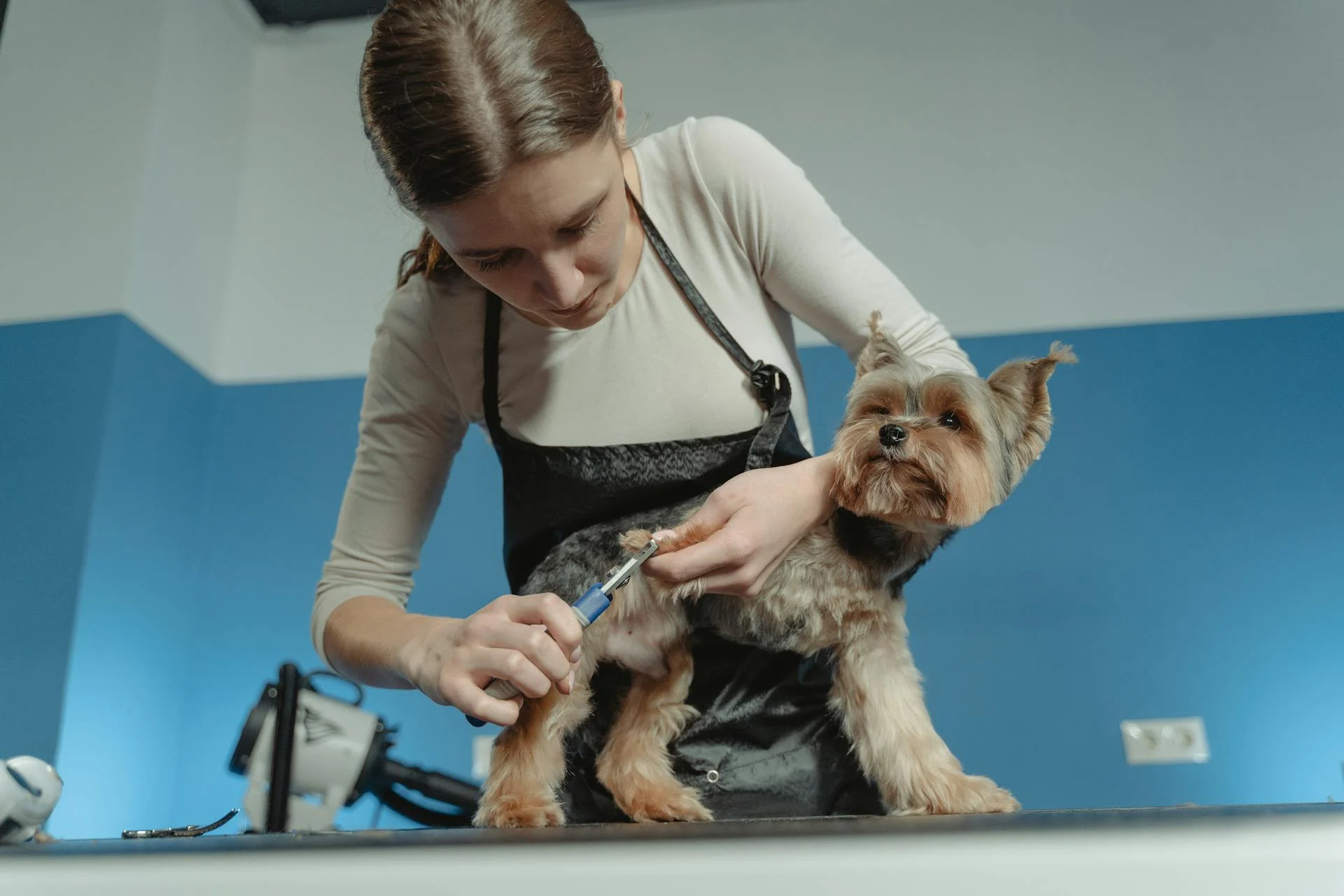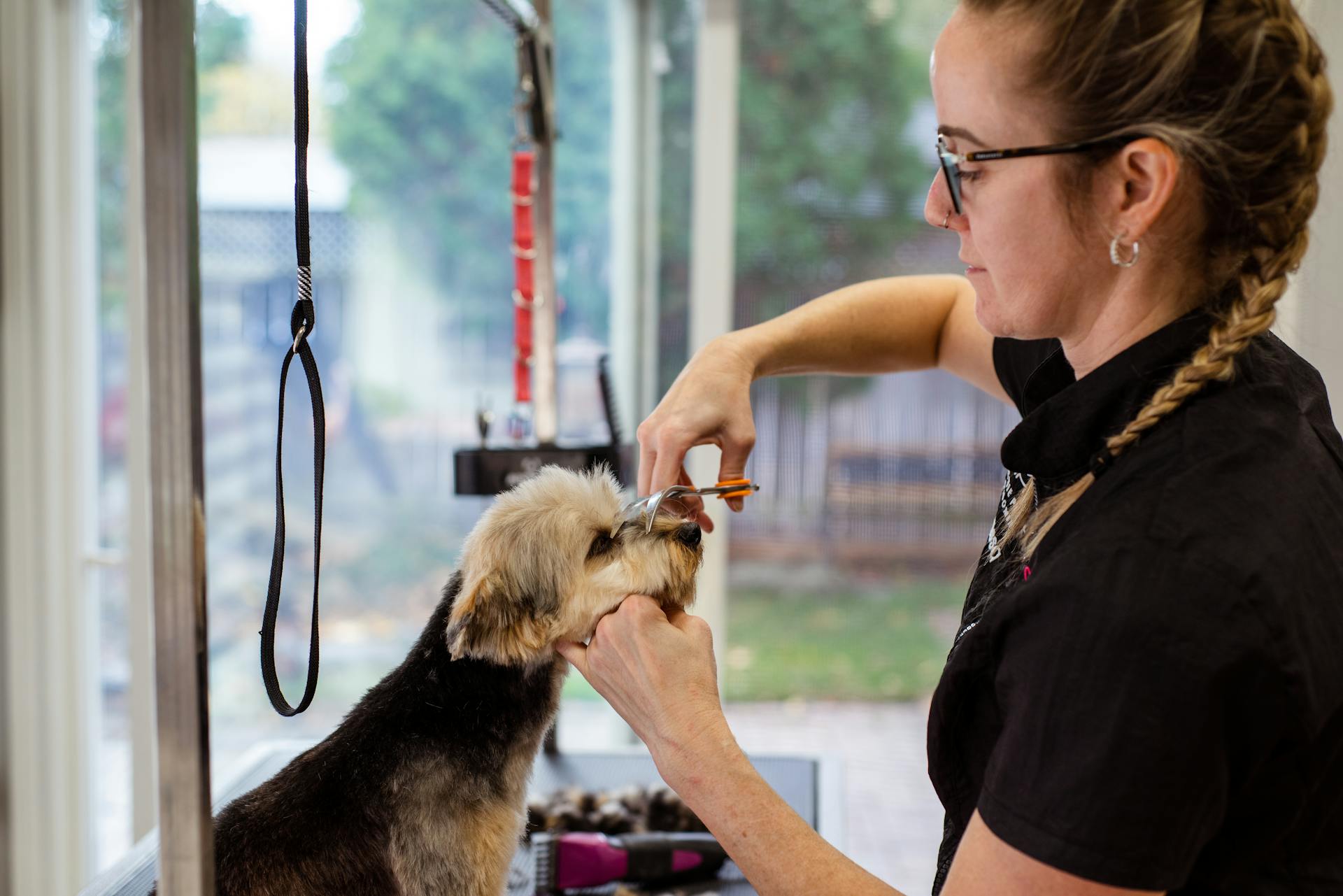
Sedating your dog for grooming can be a stressful experience for both you and your furry friend. It's essential to understand the risks and benefits of sedation to ensure your dog's safety and comfort.
Sedation is typically recommended for dogs that are anxious or aggressive during grooming, but it's not a substitute for proper training and handling. According to studies, dogs that are sedated for grooming may experience increased anxiety and stress levels after the procedure.
Dogs that are older, have medical conditions, or take certain medications may not be good candidates for sedation. It's crucial to consult with a veterinarian before sedating your dog, especially if they have a history of health issues.
The American Animal Hospital Association recommends that sedation be used only when necessary and under the guidance of a veterinarian.
Sedation Options
Sedation options for your furry friend are plentiful, but it's essential to choose the right one for a stress-free grooming experience. Benadryl is a popular choice, containing the ingredient diphenhydramine, which acts as a mild tranquilizer in dogs. This medication can be mixed with food or a tasty treat like peanut butter, but be sure to consult with a veterinarian to determine the correct dose.
For a more predictable response, injectable sedatives are often preferred. Acepromazine is a commonly prescribed oral sedative, but its effects can be inconsistent. However, the injectable form of acepromazine can provide more reliable sedation when squirted between the gums and cheek of the dog.
Some veterinarians may recommend medications traditionally used for other purposes for their sedative side effects. Anti-seizure medications like phenobarbital and gabapentin can have a profound sedative effect, making them suitable for use before a stressful event.
If you're looking for a combination of sedatives, you can consider the following options:
Remember to consult with your veterinarian to determine the best sedation option for your dog based on their specific needs and health status.
Assessing the Need
Evaluating your dog's behavior and stress levels is the first step in considering sedation for grooming. This will help you determine if your dog is a good candidate for sedation.
Some dogs exhibit signs of anxiety or aggression during grooming, making sedation a viable option. It's essential to keep in mind that every dog is different, and what works for one dog may not work for another.
Consulting with a veterinarian is crucial to understand the risks and benefits of sedation. They can help identify if your dog is a candidate for sedation and discuss possible alternatives that might be less invasive.
A veterinarian can also provide guidance on how to manage your dog's anxiety and stress levels during grooming. This may involve using calming aids or adjusting your grooming routine to make it more comfortable for your dog.
Grooming and Safety
Safety is paramount when sedating your dog for grooming. Only trained professionals should administer sedation, and close post-sedation observation is necessary to monitor recovery and prevent complications.
Continuous monitoring of vital signs during the sedation process is crucial. Emergency protocols must be in place in case of adverse reactions.
Combining sedation with grooming requires careful planning, and the timing of sedation and grooming procedures should be coordinated for maximum efficiency and minimum stress.
Grooming
Combining sedation with grooming requires careful planning to ensure maximum efficiency and minimum stress for your dog. This involves coordinating the timing of sedation and grooming procedures.
Special considerations are needed to ensure comfort and safety when grooming a sedated dog. The goal is to minimize the duration of sedation while ensuring the grooming process is completed safely.
Only trained professionals should administer sedation, and close post-sedation observation is necessary to monitor recovery and prevent complications. This is crucial for preventing adverse reactions.
Vital signs should be continuously monitored during the sedation process to ensure your dog's safety. Emergency protocols must be in place in case of any unexpected issues.
Grooming Anxiety
Grooming can quickly become a nightmare if your dog is nervous or anxious about the process.
Matted fur, dirty ears, and overly long nails are uncomfortable for your dog and can lead to more serious health issues if left untreated.
Grooming is an important part of caring for your dog's wellbeing.
If your dog is uncomfortable, the grooming process can be stressful for both of you.
Dirty ears can lead to infections, which can be painful and even cause hearing loss in severe cases.
Matted fur can cause skin irritation and even lead to skin infections if left untreated.
Overly long nails can cause discomfort and pain for your dog, making it difficult for them to walk or even stand comfortably.
Check this out: How Long Does Dog Grooming Take
Medical Considerations
Medical considerations are a crucial aspect of sedating your dog for grooming. If your dog is extremely anxious or fearful during grooming, it may be necessary to visit your vet to discuss medical sedation options.
Your vet may recommend a number of effective anti-anxiety and sedation medications for your dog, such as diazepam, acepromazine, gabapentin, or fluoxetine. These medications can help calm your dog's nerves and make the grooming process more manageable.
Never give your dog sedation medications without first consulting your veterinarian, as not all sedation medications work for all dogs.
Injectable Sedatives
Injectable sedatives are often preferred over oral sedatives because they tend to have a quicker and more predictable response in dogs. This is because the medication is absorbed directly into the bloodstream, bypassing the digestive system.
Injectable sedatives can be given in a variety of combinations, depending on the specific needs of the dog. Some popular combinations include acepromazine and butorphanol, diazepam and butorphanol, and dexmedetomidine, ketamine, and butorphanol.
The combination of dexmedetomidine, ketamine, and butorphanol can be partially reversed with atipamezole, which is an important consideration for pet owners. It's essential to discuss any questions or concerns with a veterinarian before administering sedatives to a dog.
A veterinarian can determine the best sedative for a dog based on the problem that needs to be addressed and the dog's overall health. They can also provide guidance on dosing instructions and potential side effects.
Here are some popular injectable sedatives and combinations:
- acepromazine
- acepromazine and butorphanol
- diazepam and butorphanol
- Telazol
- Telazol and butorphanol
- dexmedetomidine (can be reversed with atipamezole)
- dexmedetomidine, ketamine, and butorphanol (can be partially reversed with atipamezole)
Breed-Specific Considerations
Breed-specific considerations are crucial when it comes to sedating your dog. Certain dog breeds, such as brachycephalic breeds, may have specific considerations regarding sedation due to their unique anatomical features.
Dogs with short noses, like brachycephalic breeds, can experience breathing difficulties, which must be taken into account before sedation. Discuss any breed-specific concerns with your veterinarian before sedating your dog.
Some breeds may be more prone to certain health issues that can affect sedation, so it's essential to consider their individual needs.
Curious to learn more? Check out: All Breeds Dog Grooming
Medical

Medical considerations are crucial when it comes to ensuring your dog's well-being, especially during grooming sessions.
Medical sedation may be necessary for extremely anxious or fearful dogs, so it's essential to discuss options with your vet.
Your vet may recommend medications like diazepam, acepromazine, gabapentin, or fluoxetine to help calm your dog.
Never give your dog sedation medications without first consulting your veterinarian.
Allergies and Sensitivities
If your dog has a history of allergic reactions to medications, inform your veterinarian. This will help you make informed decisions about sedatives and ensure your dog's safety.
Some sedatives can cause adverse reactions in dogs with allergies or sensitivities. Be cautious and carefully observe your dog for any signs of an adverse reaction after administering the sedative.
Dogs with allergies or sensitivities may exhibit signs such as itching, scratching, or difficulty breathing. If you notice any of these symptoms, seek veterinary attention immediately.
Additional reading: Dog Grooming Signs
Post-Care and Risks
After sedating your dog for grooming, it's essential to prioritize their post-care and safety. Ensure your dog is in a safe and comfortable environment after the sedation wears off.
Monitoring your dog during recovery is crucial to prevent any potential risks. This includes vigilant care for signs of delayed side effects.
A comfortable recovery environment is just as important as the sedation process itself. Provide gentle care and monitoring to ensure your pet returns to normal without any lingering effects from the sedative.
Careful feeding and restricted activity are also important guidelines for post-sedation. This will help prevent any complications or discomfort for your dog.
Here are some key things to watch out for during post-sedation recovery:
- Delayed side effects
- Signs of discomfort or distress
- Difficulty eating or drinking
- Restricted activity to prevent complications
By being attentive to your dog's needs during post-sedation recovery, you can ensure a smooth and safe return to normal.
Frequently Asked Questions
What is the best sedative for dogs grooming?
For dog grooming sedation, your vet may recommend diazepam, acepromazine, gabapentin, or fluoxetine, but always consult your vet first. Consult your veterinarian to determine the best sedative for your dog's grooming needs.
Sources
- https://www.cuteness.com/article/sedate-dog-haircut
- https://gougoupets.com/sedating-a-dog-for-grooming/
- https://www.petmd.com/dog/general-health/sedatives-dogs-how-and-when-use-them-safely
- https://www.johnscreekvet.com/site/blog/2022/07/30/how-keep-dog-calm-while-grooming
- https://dogsbestlife.com/dog-grooming/nail-clippers/
Featured Images: pexels.com


